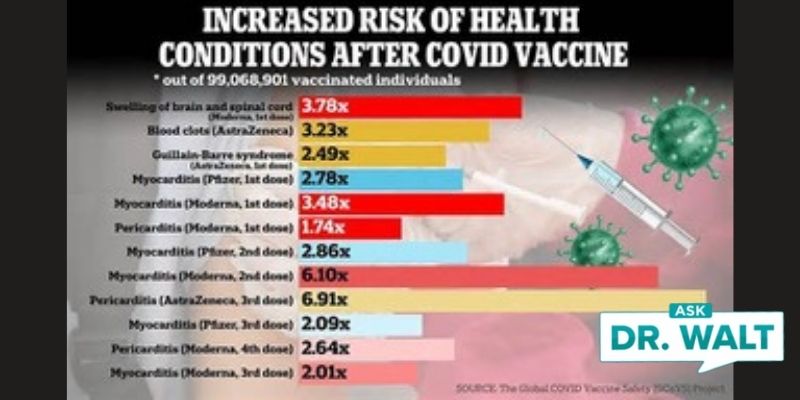What to do for the disturbing symptoms of long COVID?

More sleep may help adults lose weight
March 10, 2022
“At First Light,” my WWII book, releases in about five weeks
March 12, 2022As I told you earlier this week, I’m blessed to be a small part of a great team of healthcare professionals at UCHealth and the University of Colorado. I thought you’d be interested in their latest information on caring for folks who have long COVID.
The COVID-19 pandemic has taken the world on a wild ride.
There have been surges, plateaus, ebbs, and flows of infections, illnesses, hospitalizations, and deaths as the COVID (SARS-CoV-2) virus cuts its unpredictable path. For now, at least, the wave of cases is in sharp decline.
Yet even if the virus were to somehow vanish tomorrow, legions of individuals who survived COVID-19 would be left with mysterious reminders of their infections, collectively known as long COVID.
According to the Centers for Disease Control and Prevention, these COVID “long haulers” are those who experience symptoms four weeks or longer after the original infection. After that, much remains murky about long COVID. Those who spent long stints in intensive care units, many on ventilators, are at obvious risk of suffering long-term symptoms. But long haulers also include those who had moderate, mild, or even no COVID-19 symptoms. The problems vary widely and symptoms include chronic fatigue, brain fog (aka COVID brain), depression, shortness of breath, loss of taste and smell, hair loss, and more. The signs and symptoms may resolve in a matter of weeks or stubbornly hang on.
A complex condition that defies easy answers requires multiple minds to explore it. That’s the approach of the UCHealth Post-COVID Clinic. It brings together specialists in critical care, pulmonology, cardiology, physical medicine and rehabilitation, psychiatry, neurology, and more to craft treatment plans that address each patient’s long COVID challenges.
To learn more, UCHealth Today spoke with Dr. Sarah Jolley, assistant professor of Pulmonary Sciences & Critical Care Medicine at the University of Colorado School of Medicine on the Anschutz Medical Campus. Jolley is the medical director of the clinic.
Just how prevalent is long COVID?
“It’s a complicated question because symptoms after a bout with COVID-19 can be the result of underlying, pre-existing conditions,” Jolley said. More on that later. But she estimated that 10-to-20 percent of patients who contracted COVID-19 experience long COVID, meaning one or more persistent symptoms they had not had prior to infection.
“We’re hoping to see less long COVID after omicron, but we don’t know yet,” Jolley said.

Does a lengthy ICU stay after a COVID-19 infection put me at greater risk of experiencing long COVID?
Yes, but people confined to ICUs for long periods are at risk of developing post-intensive care syndrome (PICS), regardless of their illness or injury, Jolley said. PICS refers to a collection of physical, cognitive, and mental health challenges that hang on for long periods after hospitalization – much like long COVID.
“COVID-19 ICU survivors are much like those who survive other causes of severe illnesses,” Jolley said. “Long COVID in these cases mirrors PICS, which was described before we had COVID.”
So if I didn’t get very sick from COVID-19, am I in the clear for long COVID?
No. “We’ve been seeing patients who had mild to moderate cases of COVID-19,” Jolley said.
What are the most common symptoms of long COVID?
Jolley listed ongoing shortness of breath, chronic cough, and fatigue as three that she often sees.
But a host of others appear regularly, including brain fog and confusion; headaches; nerve problems, such as tingling and pain in the extremities; chest pain; and heart palpitations.
Some symptoms are even more confusing and difficult to address, Jolley said.
These include persistent loss of taste and smell, hair loss, and orthostatic intolerance, or dysautonomia, which disrupts the autonomic nervous system – the one that governs bodily functions like heart rate and blood pressure. One of the many symptoms: dizziness when a person moves from lying down to standing.
How does the UCHealth Post-COVID Clinic address long COVID concerns?
The clinic is multidisciplinary, which means that specialists work together to address the broad range of long COVID symptoms patients suffer. A nurse navigator screens referrals to understand each patient’s needs upfront, Jolley said.
“Based on that, patients are set up for multidisciplinary visits on the same day for the systems involved,” she said. After a two- to two-and-a-half-hour exam, specialists meet to develop an individualized recovery plan. The approach minimizes testing, prevents multiple visits, and sets the patient on a defined treatment course, Jolley explained.
If I have persistent symptoms after COVID, do I necessarily have long COVID?
No. Jolley said many patients’ post-COVID symptoms may be attributed to underlying conditions, including other viral infections, heart disease, thyroid disease, mood disorders, and more.
“My concern as a physician who sees long COVID patients is there is a tendency for health care providers to attribute anything that happens after COVID to the fact that a patient had COVID,” she said. “But certainly patients are at risk for all the things they had before COVID. It’s important for care providers to make sure that we’re ruling out all of the non-COVID issues as well.”
Is there an overlap between the symptoms of long COVID and other conditions?
Yes. That’s one of the major difficulties in addressing long COVID, Jolley said. For example, the chronic cough reported by patients who recovered from COVID may be related to pre-existing asthma. At the same time, some COVID patients who have never had asthma may struggle with a persistent cough because the virus inflames their airways, she added. “It doesn’t seem to predispose them to future asthma,” she noted, although the cough tends to last longer for COVID patients than for patients who recover from the flu or respiratory syncytial virus (learn more about RSV and its symptoms).
Does hair loss for long COVID patients fall in that category?
Yes. Some patients have reported their hair falling out in clumps after recovering from COVID. It’s a problem that “can be very concerning,” Jolley acknowledged but added that the shedding is usually temporary. She added that the condition, called telogen effluvium, can also be traced to thyroid disease, illness with high fever, and other causes.
“We recommend that clinics and primary care providers make sure that there is not an underlying problem that is leading to the hair loss,” Jolley said.
What do we know about the chronic fatigue that frequently seems to follow long COVID?
“This is an important area of study, with a focus on the possibility that long COVID symptoms again overlap with another condition, myalgic encephalomyelitis/chronic fatigue syndrome (ME/CFS),” Jolley said. “Many of the symptoms of ME/CFS mirror those reported by long COVID patients, including sleep problems, joint and muscle pain, brain fog, and cognitive impairment. It’s difficult to untangle the source of the symptoms in patients struggling after a COVID bout,” Jolley said.
A November 2021 paper in the Mayo Clinic Proceedings emphasized the difficulty of providing meaningful clinical help for patients suffering from these symptoms. The authors noted that ME/CFS was often undiagnosed or inadequately treated long before COVID-19 arrived.
“These problems are of increasing importance because, after acute COVID-19, a significant percentage of people remain ill for many months with an illness similar to ME/CFS,” they wrote.
What can be done to address chronic fatigue for long COVID patients?
Jolley reiterated the importance of identifying, if possible, other underlying causes of the problem. A “consensus guidance statement” co-authored by Dr. William Niehaus, assistant professor of Physical Medicine and Rehabilitation at CU (and a provider in the UCHealth Post-Covid Clinic) noted that these include inadequate sleep and nutrition; infectious and autoimmune diseases; and heart, lung, and nerve disorders.
The authors offer a series of recommendations to treat fatigue that include developing a phased return-to-activity program; devising strategies to help patients conserve energy; encouraging healthy eating and adequate hydration, and prescribing appropriate medications and herbal and vitamin supplements.
Are there resources I can use to help myself with long COVID symptoms?
Yes. Jolley said she frequently refers patients to Survivor Corps, a patient advocacy group whose website contains extensive information on long COVID. For patients dealing with the loss of taste and smell – another frequently reported post-COVID symptom – Jolley recommends the United Kingdom-based Fifth Sense, which includes tools for self-testing and training. The UCHealth Ear, Nose, and Throat Clinic – Anschutz Medical Campus also offers help with this problem. Learn about ideas for getting your taste and smell back.
For patients struggling with the chronic medical and mental health challenges of long COVID, the Psychiatry Consultation for the Medically Complex service, led by Dr. Thida Thant, assistant professor of Psychiatry at CU, provides a Coping with Illness support group within the UCHealth Outpatient Psychiatric Clinic.
“We find sometimes that our patients are coming from small towns where their docs may not have seen long COVID yet,” Jolley said. “Being able to connect with someone who is experiencing something similar and saying, ‘this is real’ can be very meaningful.”
It’s been nearly two years since COVID-19 came on the scene. What have we learned about long COVID?
“In the beginning, there was a thought that long COVID was one singular thing,” Jolley said. “We’ve learned over time that there are subsets of patients with different constellations of symptoms.” That recognition underscores the importance of taking the multidisciplinary approach of the Post-COVID Clinic.
“Also, for the most part, patients with long COVID get better over time,” Jolley said. “I don’t think we fully understand it yet, but with enough time, the symptoms do lessen.”
An important and unanswered question with COVID generally and long COVID, in particular, is why the virus affects patients so differently.
“It suggests there may be different immune profiles among long COVID patients,” Jolley said. One subject of recent research, for example, is autoantibodies – those that target the body’s own tissues, as in rheumatoid arthritis and lupus. The study of some 300 COVID patients suggests that specific autoantibodies trigger some of the symptoms of long COVID, Jolley said.
The same study and another published in June 2021 pointed to a connection between long COVID symptoms and the Epstein-Barr virus, which lies dormant in most of us. The suspicion is that in some people, inflammation triggered by the SARS-CoV-2 virus reactivates the Epstein-Barr virus and leads to long COVID symptoms. These and other studies are probing the bodily mechanisms that underlie long COVID, Jolley said.
Is more research on long COVID on the horizon?
Yes. Perhaps the most important is a large National Institutes of Health study called RECOVER. The initiative aims to recruit some 17,000 patients across the United States, including long COVID patients, those who recovered without long COVID, and healthy controls. University of Colorado Anschutz Medical Campus is part of a consortium with the University of Utah, Intermountain Healthcare, University of New Mexico, and Denver Health and Hospitals that will be recruiting, enrolling, and studying patients.
The RECOVER initiative has already yielded some research contributions. They include a project in which Jolley and a team of CU biostatisticians and data analysts used machine learning and artificial intelligence to scour the electronic health record for patients at risk for long COVID.
“RECOVER should give us a good understanding of the biologic basis for the abnormalities we are seeing after COVID infections,” Jolley said. With that, she added, we can begin to answer not only what long COVID does, but why.
This blog was accurate as of the day of posting. However, as the COVID-19 pandemic rapidly evolves and the scientific community’s understanding of the novel coronavirus and the COVID vaccine develops, the information above may have changed since it was last updated. While I aim to keep all of my blogs on COVID and the COVID vaccine up to date, please visit online resources provided by the CDC, WHO, and your local public health department to stay informed on the latest news.
© Copyright WLL, INC. 2022. This blog provides a wide variety of general health information only and is not intended to be a substitute for professional medical advice, diagnosis, or treatment from your regular physician. If you are concerned about your health, take what you learn from this blog and meet with your personal doctor to discuss your concerns.







